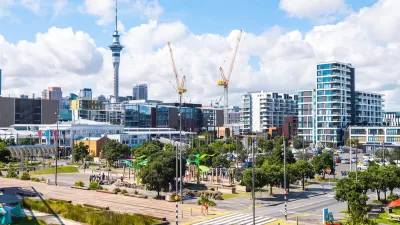A recent study suggesting that mixed-use zoning increases crime is not as persuasive as it might seem at first glance.
A recent study published in the University of Pennsylvania Law Review analyzes the crime rates of numerous blocks in Los Angeles, and concludes that single-use residential areas have the lowest crime rates. (The article also suggests that mixed-use places have less crime than commercial blocks). According to the authors' logic, the isolation of commerce from housing protects us all from crime- at least if we don't bother to visit commercial places. (By this logic, the only safe place to shop is online!)
It seems to me that the article's attempt to compare mixed-use and single-use places is inherently flawed. Suppose that mixed-use block A has 100 residents and 20 crimes per year, while single-use residential block B has 200 people and 10 crimes per year. At first glance, block A has far more crime: it has 20 crimes per 100 residents while block B has only 5.
But this logic overlooks something. Block B will almost never have more than 200 people on any given day (except for occasional visitors); thus, it makes sense to evaluate Block B's crime rates by dividing the number of crimes by the number of residents, But mixed-use Block A's real universe of potential victims is not just the 100 residents of that block: it is the 100 residents PLUS the people who come to Block A to shop and work. So if Block A has 400 commercial visitors per day, its real population is 500 (the residents plus the visitors). Thus, a better way to calculate Block A's crime rate is to divide its 20 crimes by 500 residents. Under this method, Block A has only 4 crimes per 100 people- fewer than Block B!

Alabama: Trump Terminates Settlements for Black Communities Harmed By Raw Sewage
Trump deemed the landmark civil rights agreement “illegal DEI and environmental justice policy.”

Study: Maui’s Plan to Convert Vacation Rentals to Long-Term Housing Could Cause Nearly $1 Billion Economic Loss
The plan would reduce visitor accommodation by 25% resulting in 1,900 jobs lost.

Planetizen Federal Action Tracker
A weekly monitor of how Trump’s orders and actions are impacting planners and planning in America.

Wind Energy on the Rise Despite Federal Policy Reversal
The Trump administration is revoking federal support for renewable energy, but demand for new projects continues unabated.

Passengers Flock to Caltrain After Electrification
The new electric trains are running faster and more reliably, leading to strong ridership growth on the Bay Area rail system.

Texas Churches Rally Behind ‘Yes in God’s Back Yard’ Legislation
Religious leaders want the state to reduce zoning regulations to streamline leasing church-owned land to housing developers.
Urban Design for Planners 1: Software Tools
This six-course series explores essential urban design concepts using open source software and equips planners with the tools they need to participate fully in the urban design process.
Planning for Universal Design
Learn the tools for implementing Universal Design in planning regulations.
Caltrans
Smith Gee Studio
Institute for Housing and Urban Development Studies (IHS)
City of Grandview
Harvard GSD Executive Education
Toledo-Lucas County Plan Commissions
Salt Lake City
NYU Wagner Graduate School of Public Service






























